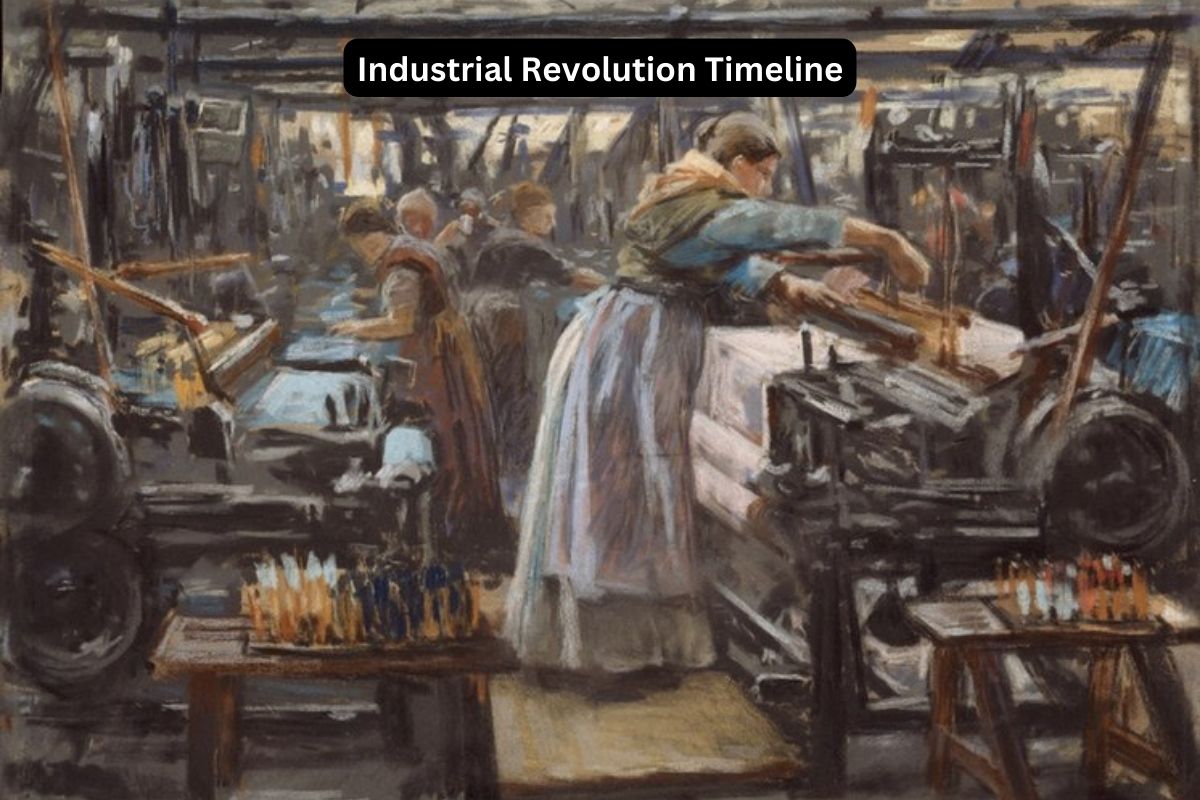The Industrial Revolution was a transformative period in history, spanning from the late 18th century into the early 20th century. It marked a profound shift from agrarian and craft-based economies to industrial and manufacturing-driven societies.
During this era, technological innovations, such as steam engines, mechanized textiles, and electrical power, revolutionized industries, transportation, and daily life.
This period also witnessed the emergence of significant social and economic changes, including urbanization, labor movements, and the globalization of trade.
In this context, we will explore key developments and milestones that defined the Industrial Revolution’s progression, from its early beginnings to its far-reaching impact on the modern world.
| Year | Event/Invention |
|---|---|
| 1760s-1780s | The First Industrial Revolution begins in Britain with the mechanization of the textile industry. |
| 1781 | James Watt invents an improved steam engine. |
| 1793 | Eli Whitney invents the cotton gin. |
| Early 19th century | The development of canals and improved transportation infrastructure. |
| 1804 | Richard Trevithick builds the first successful steam-powered locomotive. |
| 1814 | George Stephenson designs the first practical steam locomotive. |
| 1820s-1830s | The Second Industrial Revolution begins, characterized by innovations in iron and steel production. |
| 1831 | Cyrus McCormick invents the mechanical reaper. |
| 1837 | Samuel Morse invents the telegraph. |
| 1840s-1850s | The use of interchangeable parts and assembly line production methods. |
| 1859 | The discovery of oil in Pennsylvania. |
| 1860s-1870s | The development of the Bessemer process for mass steel production. |
| 1876 | Alexander Graham Bell invents the telephone. |
| Late 19th century | The Third Industrial Revolution begins with the widespread use of electricity and the development of the automobile. |
| 1886 | Karl Benz builds the first gasoline-powered automobile. |
| 1892 | The first long-distance electric power transmission line is established. |
| Late 19th century | The expansion of industrialization to other countries. |
| Early 20th century | Advancements in aviation, chemical industries, and mass production techniques. |
Timeline of the Industrial Revolution
1. The First Industrial Revolution begins in Britain with the mechanization of the textile industry in the 1760s-1780s
The Industrial Revolution began in Britain in the late 18th century. It was characterized by the mechanization of various industries, starting with the textile industry. Before this period, textile production was primarily a manual and labor-intensive process.
Also Read: Facts About the Industrial Revolution
However, inventions like the spinning jenny and the water frame, developed by inventors like James Hargreaves and Richard Arkwright, allowed for the mechanized spinning of yarn and weaving of cloth. This transition from manual labor to machinery marked the initial phase of industrialization.
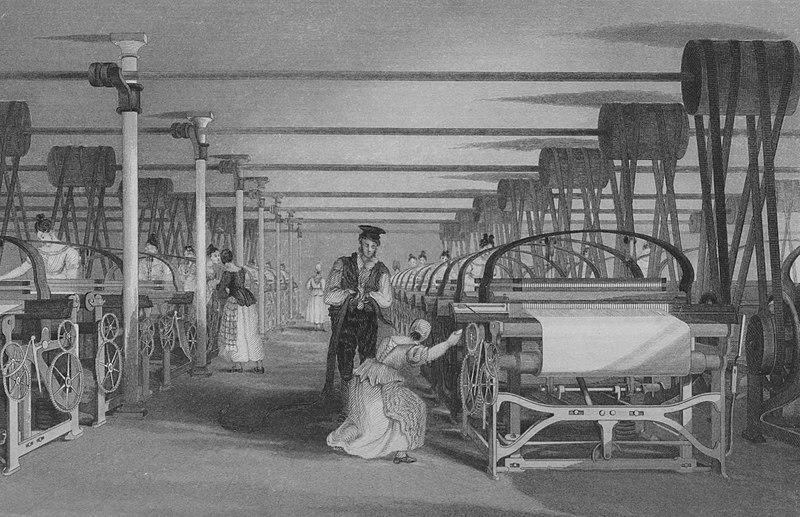
2. In 1781, James Watt invents an improved steam engine
James Watt, a Scottish engineer, made a groundbreaking contribution to the Industrial Revolution with his improved steam engine.
While steam engines existed before Watt’s improvements, his design significantly increased their efficiency and practicality. Watt’s steam engine became a crucial power source for a wide range of industries, including mining, transportation, and manufacturing.
It played a pivotal role in powering the machinery that would drive the industrialization of Britain and later the world.
3. Eli Whitney invents the cotton gin in 1793, revolutionizing cotton production
In the United States, the cotton industry was a vital part of the economy, but it faced a significant challenge due to the labor-intensive process of separating cotton fibers from their seeds. Eli Whitney’s invention of the cotton gin revolutionized cotton production.
Also Read: Gilded Age Facts
The cotton gin could quickly and efficiently separate cotton fibers from the seeds, making cotton cultivation much more profitable.
This innovation led to a boom in cotton production, especially in the Southern United States, and contributed to the growth of the textile industry in both the U.S. and Europe.
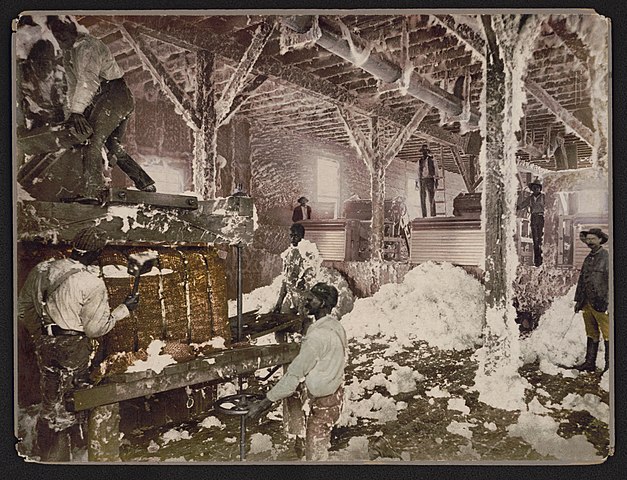
4. The early 19th century sees the development of canals and improved transportation infrastructure
The early 19th century witnessed significant developments in transportation and infrastructure, which played a critical role in the Industrial Revolution. Canals were constructed to improve the transportation of goods, making it easier to move raw materials and finished products.
This period also saw the expansion of road networks and the improvement of existing roads. Efficient transportation networks helped connect industrial centers with resource-rich areas and markets, facilitating the flow of goods and further boosting industrialization.
5. In 1804, Richard Trevithick builds the first successful steam-powered locomotive
In 1804, Richard Trevithick built the first successful steam-powered locomotive. Although it was primarily used for hauling iron and coal in mines, it marked the early experimentation with steam locomotion.
6. George Stephenson designs the first practical steam locomotive in 1814
George Stephenson’s design of the “Rocket” locomotive in 1829 is often regarded as a pivotal moment in railway history. It was the first practical and efficient steam locomotive for railway transport, leading to the rapid expansion of railways in the following decades.
The development of railways revolutionized transportation by enabling faster and more reliable movement of people and goods over long distances. Railways played a critical role in the Industrial Revolution by connecting industrial centers to raw materials and markets, promoting economic growth.
7. The Second Industrial Revolution begins in the 1820s-1830s with innovations in iron and steel production
The Second Industrial Revolution was marked by innovations in iron and steel production. The widespread use of the Bessemer process in the 1850s allowed for the mass production of steel, a stronger and more versatile material than iron.
Steel became a fundamental building block for infrastructure, including bridges, buildings, and railways. The construction of large iron and steel structures transformed architecture and engineering.
This era also saw advancements in machinery, including the development of more efficient textile machines and the use of steam engines in various industries beyond textiles.
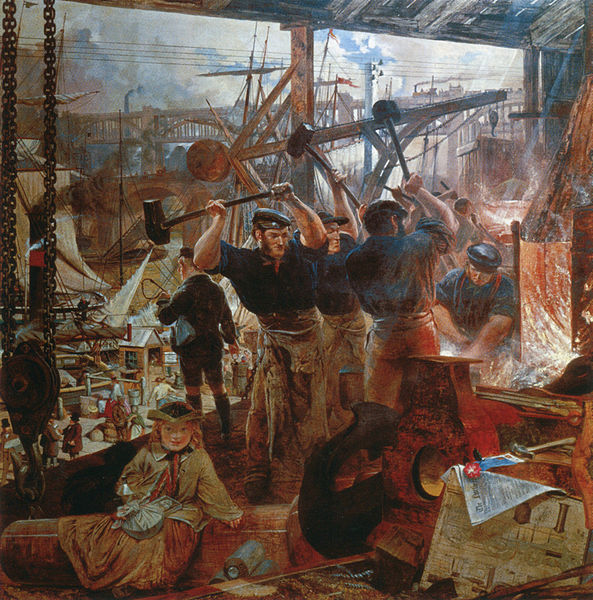
8. In 1831, Cyrus McCormick invents the mechanical reaper, transforming agriculture
Cyrus McCormick’s invention of the mechanical reaper in 1831 revolutionized agriculture by automating the harvesting of crops like wheat. This invention significantly increased agricultural productivity, reduced labor requirements, and allowed for the cultivation of larger areas of land.
The mechanical reaper had a profound impact on farming practices, contributing to increased food production and the ability to feed growing urban populations.
9. Samuel Morse invents the telegraph in 1837, revolutionizing long-distance communication
Samuel Morse’s invention of the telegraph in 1837 revolutionized long-distance communication. The telegraph transmitted messages over long distances using electrical signals and Morse code.
The telegraph enabled rapid communication between distant locations, improving business and government operations, and eventually laying the groundwork for the modern telecommunications industry.
10. The 1840s-1850s witness the use of interchangeable parts and assembly line production methods
The mid-19th century saw the adoption of interchangeable parts and assembly line production techniques in manufacturing. Eli Whitney, known for the cotton gin, also promoted the use of interchangeable parts in firearm manufacturing.
Interchangeable parts and assembly lines allowed for more efficient and cost-effective production of goods. Products could be assembled quickly from standardized components, reducing production time and costs.
11. In 1859, the discovery of oil in Pennsylvania leads to the development of the petroleum industry
In 1859, Edwin Drake drilled the first commercial oil well in Titusville, Pennsylvania. This event marked the beginning of the petroleum industry.
The discovery of oil led to the development of new industries, including refining and the production of kerosene for lighting. Later, the internal combustion engine would drive the demand for gasoline, transforming transportation.
12. The 1860s-1870s see the development of the Bessemer process for mass steel production
The Bessemer process, invented by Sir Henry Bessemer, revolutionized the steel industry by introducing a cost-effective and efficient method for mass steel production.
Key features included a specialized converter for molten iron, high-pressure air injection to remove impurities and excess carbon, and automation.
This innovation enabled the widespread use of steel in railways, construction, manufacturing, and armaments, profoundly impacting industrialization and modernization.
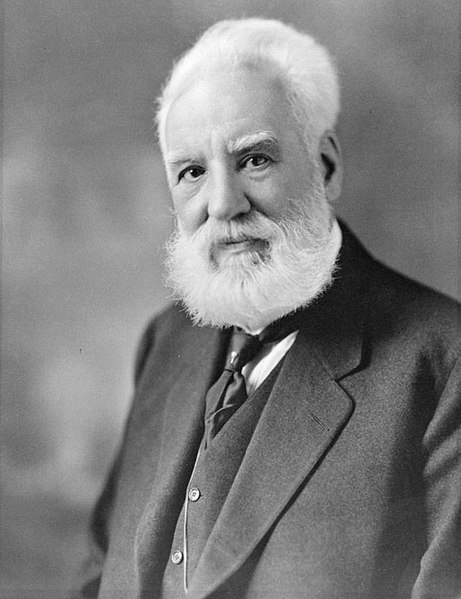
13. Alexander Graham Bell invents the telephone in 1876, another major communication advancement
In 1876, Alexander Graham Bell invented the telephone, which revolutionized communication by allowing voice transmission over long distances.
The telephone transformed business, personal communication, and even emergency services. It played a crucial role in connecting people and businesses across great distances, fostering economic growth and cultural exchange.
14. The late 19th century marks the beginning of the Third Industrial Revolution, characterized by the widespread use of electricity and the development of the automobile
The late 19th century marked the beginning of the Third Industrial Revolution, which brought about significant technological advancements, including the widespread use of electricity.
The development of electrical power generation and distribution systems allowed industries to transition from reliance on steam power to electric power. This shift greatly improved efficiency and reduced the need for on-site steam engines.
The expansion of electrical power also led to the electrification of homes and cities, transforming daily life by providing lighting, powering appliances, and enabling the growth of new industries such as the electric motor and electronics.
15. In 1886, Karl Benz builds the first gasoline-powered automobile
In 1886, Karl Benz built the first gasoline-powered automobile, the Benz Patent-Motorwagen. This invention marked the birth of the automotive industry.
The automobile revolutionized transportation, offering individual mobility and transforming the way people lived and worked. It led to the development of road infrastructure and the growth of the oil and petroleum industries.
16. The first long-distance electric power transmission line is established in 1892
In 1892, the first long-distance electric power transmission line was established by inventor William Stanley. This achievement allowed electrical power to be generated at central plants and transmitted over long distances to serve distant communities and industries.
Long-distance electric power transmission was a critical factor in the widespread adoption of electric power for various applications, including industrial machinery, lighting, and electric transportation.
17. Industrialization continues to expand to other countries in the late 19th century
By the late 19th century, industrialization had spread from its birthplace in Britain to other parts of Europe, North America, and beyond. Other countries, including Germany, the United States, and Japan, experienced rapid industrial growth.
The expansion of industrialization had profound effects on global trade, as nations engaged in economic competition and imperialism. This period of expansion often included the exploitation of resources in colonies and led to significant geopolitical changes.
18. The early 20th century witnesses advancements in aviation, chemical industries, and mass production techniques.
The early 20th century saw significant advancements in aviation technology. The Wright brothers, Orville and Wilbur Wright, achieved the first powered, controlled, and sustained flight in 1903 with their Wright Flyer.
These aviation pioneers paved the way for the development of airplanes and the aviation industry. By World War I, airplanes were used for reconnaissance and combat, marking a crucial moment in military aviation.
The late Industrial Revolution witnessed significant growth in the chemical industry. Innovations in chemistry and materials science led to the development of new synthetic materials and chemicals.
Advancements in chemical processes, such as the Haber-Bosch process for ammonia synthesis, played essential roles in the production of fertilizers and explosives. Additionally, synthetic plastics like Bakelite and Nylon emerged during this period, revolutionizing manufacturing and consumer goods.
